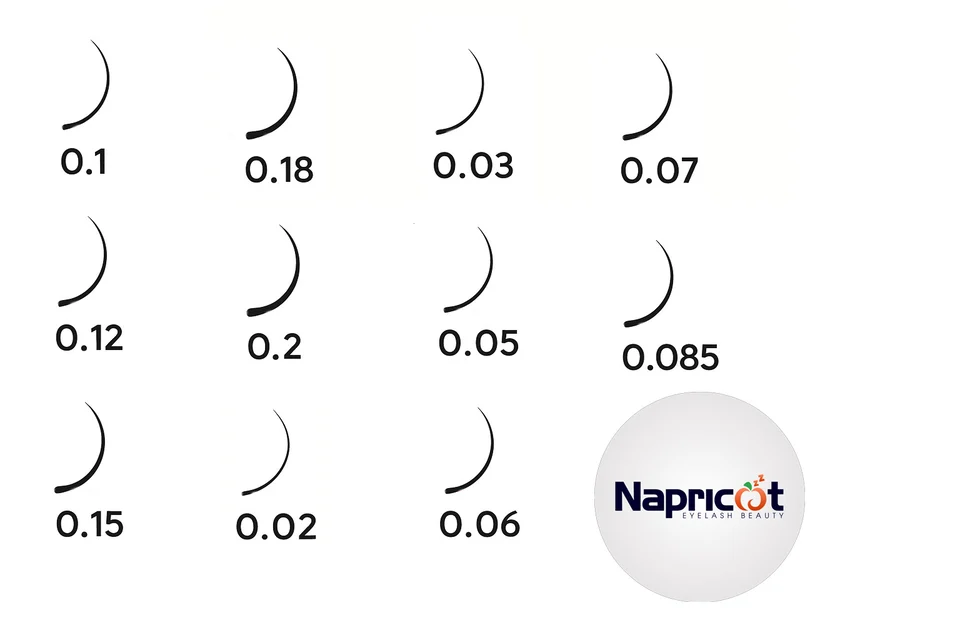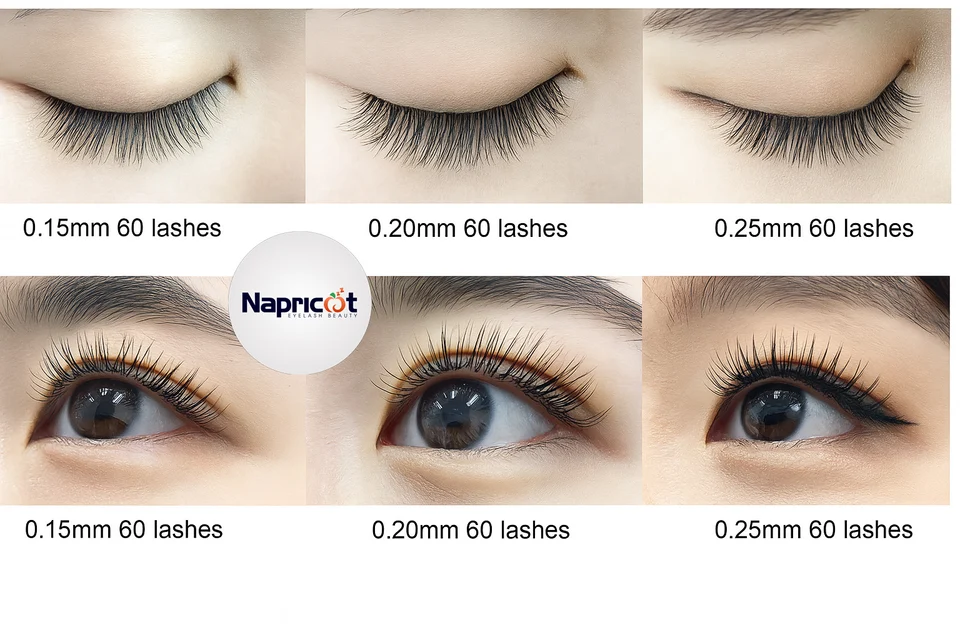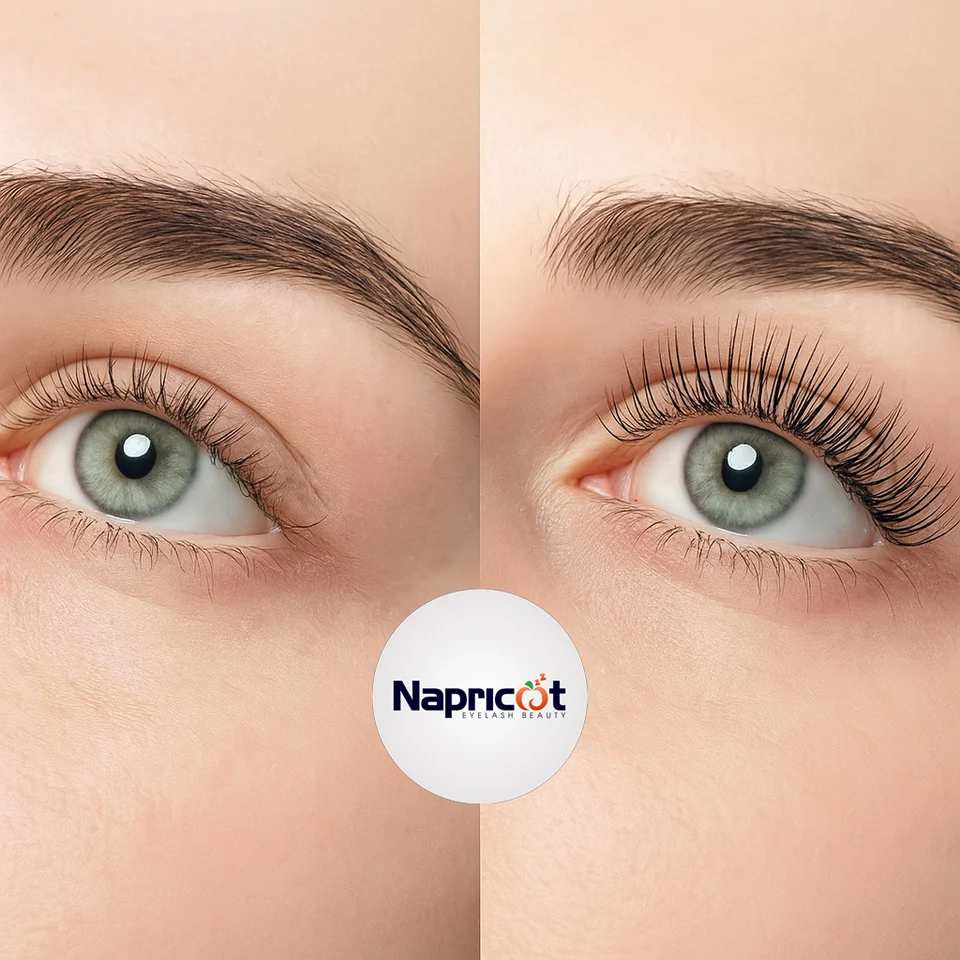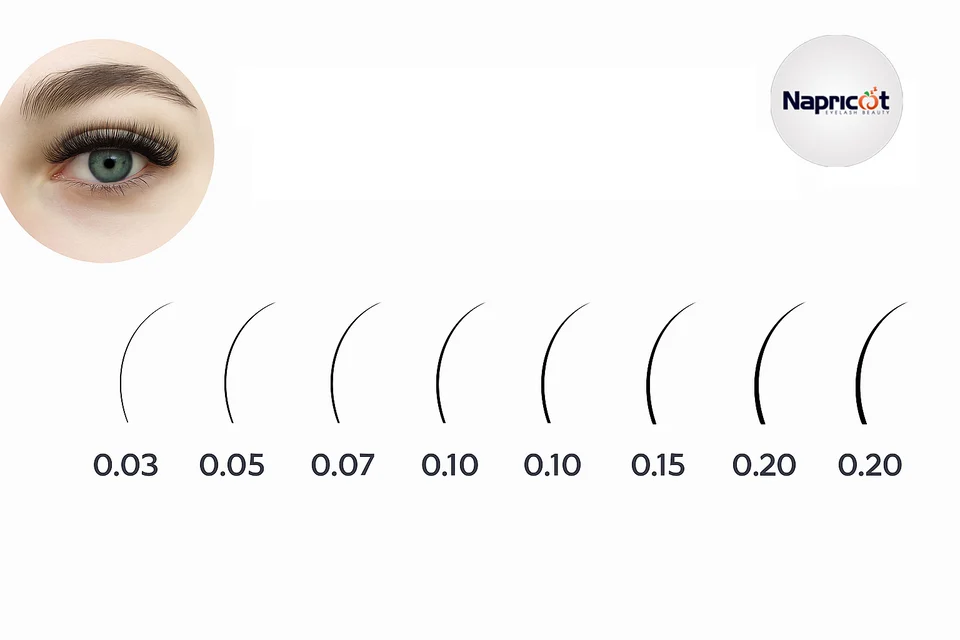Lash Extension Thickness Guide: Choose the Perfect Diameter
Lash extension thickness refers to the diameter of individual lash extensions, measured in millimeters (mm). It typically ranges from 0.02mm (ultra-fine) to 0.25mm (thick).
Choosing the right thickness is crucial for balancing the desired look, whether natural or dramatic and maintaining the health of natural lashes.
Thinner lashes (0.03–0.07mm) are ideal for volume techniques and clients with delicate natural lashes, while thicker lashes (0.10–0.20mm) suit classic sets and stronger natural lashes.
Using extensions that are too thick or heavy can cause lash damage and discomfort.
Proper assessment of natural lash strength and professional application ensures optimal results and lash longevity. This article will help you better understand eyelash extension thickness.
What is Lash Extension Thickness?

Defining Lash Extension Thickness
Lash extension thickness refers to the diameter or width of individual synthetic lash fibers used in the extension application process.
This measurement is expressed in millimeters (mm) and represents the cross-sectional width of each extension fiber. Key characteristics thickness of eyelash extensions:
- Measured in millimeters ranging from 0.02mm to 0.25mm
- Directly impacts the weight and appearance of the final lash set
- Determines the application technique and fan size possibilities
- Influences client comfort and natural lash health
Common Thickness Ranges
The beauty industry offers various thickness options to accommodate different lash styles and client needs:
- Ultra-fine range: 0.02mm - 0.05mm for mega volume techniques
- Thin to medium range: 0.06mm - 0.12mm for versatile applications
- Thick range: 0.15mm - 0.20mm for dramatic, bold looks
- Excessively thick: Above 0.25mm (generally not recommended)
Why Thickness Matters
Choosing appropriate eyelash extension thickness is crucial for several reasons:
- Natural lash preservation: Prevents overloading and potential damage
- Aesthetic achievement: Ensures desired look is achieved safely
- Client comfort: Maintains wearability throughout the extension lifecycle
- Professional reputation: Demonstrates expertise and care for client well-being
Types of Lash Extension Thickness and Their Applications

Ultra-fine Lashes (0.02 – 0.05 mm)
Primary Applications:
- Mega volume sets with 10D-20D fans
- Russian volume techniques for maximum fullness
- Clients seeking dramatic density without weight
Benefits and Considerations:
- Advantages: Extremely lightweight, allows for dense fan creation, minimal strain on natural lashes
- Challenges: Requires advanced technical skills, precise handling, and specialized fanning techniques
- Best for: Experienced lash artists working with clients who have weak or fine natural lashes
Thin to Medium Lashes (0.06 – 0.12 mm)
Versatile Applications:
- 0.06mm-0.07mm: Perfect for 3D-6D volume sets, balancing fullness with safety
- 0.085mm-0.10mm: Ideal for clients with medium-strength natural lashes
- 0.12mm: Excellent for classic lash sets and smaller volume fans
Key Advantages:
- Versatility across multiple application techniques
- Suitable for various natural lash conditions
- Easy handling for lash artists of all skill levels
- Balanced aesthetics between natural and dramatic looks
Thick Lashes (0.15 – 0.20 mm)
Dramatic Applications:
- Classic lash sets for bold, defined looks • Small volume fans (2D-3D maximum)
- Special event and glamour applications
Important Considerations:
- Client suitability: Only appropriate for clients with strong, healthy natural lashes
- Weight management: Requires careful assessment of natural lash strength
- Application precision: Demands expert placement to prevent damage
- Maintenance: May require more frequent touch-ups due to weight
Excessively Thick Lashes (>0.25 mm)
Professional Recommendations:
- Generally not recommended for regular lash extension applications
- High risk factors: Potential for natural lash breakage, discomfort, premature shedding
- Limited applications: Only suitable for very strong, exceptionally healthy natural lashes
- Professional liability: May lead to client dissatisfaction and lash damage
Impact on Natural Lash Health and Aesthetics

Weight and Strain on Natural Lashes
The relationship between lash extension thickness and natural lash health is direct and significant:
- Thicker extensions = heavier weight = increased strain
- Natural lashes have limited weight-bearing capacity
- Overloading can lead to premature natural lash cycle disruption
- Proper thickness selection preserves natural lash integrity
Risks of Damage
Potential complications from inappropriate thickness selection:
- Natural lash breakage: Occurs when extensions exceed natural lash strength capacity
- Premature fallout: Results from excessive weight causing accelerated shedding
- Traction alopecia: Long-term damage from consistent overloading
- Comfort issues: Client discomfort affecting daily activities
Client Comfort and Retention
Factors affecting client experience:
- Appropriate thickness: Ensures comfortable wear throughout extension lifecycle
- Proper weight distribution: Prevents feeling of heaviness or strain
- Natural movement: Maintains natural lash flexibility and comfort
- Long-term satisfaction: Promotes client retention and referrals
Balancing Aesthetics and Health
Professional approach to thickness selection:
- Prioritize natural lash health over dramatic aesthetics
- Educate clients about safe thickness limitations
- Offer alternative techniques to achieve desired looks safely
- Regular assessment and adjustment of thickness choices
Calculating Lash Extension Weight and Safe Limits
Understanding Lash Weight Calculation
Mathematical formula for extension weight: Weight = (Diameter/2)² × 3.14 × Length × Number of Extensions Practical application:
- Calculate total weight per natural lash before application
- Consider cumulative weight across entire lash line
- Factor in adhesive weight and additional materials
- Compare against safe weight limits for natural lash strength
Safe Weight Limits for Natural Lashes
Guidelines based on natural lash condition:
- Thin/weak natural lashes: Maximum 0.10 grams per lash
- Normal/healthy natural lashes: Safe range 0.15-0.20 grams per lash
- Strong/thick natural lashes: Can support 0.25-0.30 grams per lash
Assessment factors:
- Natural lash diameter and strength
- Overall lash health and condition
- Client age and hormonal factors
- Previous extension history and tolerance
Importance in Volume Lashing
Critical considerations for volume applications:
- Multiple extensions per natural lash increase total weight exponentially
- Thickness of eyelash extensions selection becomes more crucial in volume work
- Fan size must be adjusted based on individual extension thickness
- Precise calculation prevents natural lash overloading
Guide to Choosing the Right Lash Thickness

Assessing Natural Lash Health
Comprehensive evaluation process:
- Visual inspection: Assess lash density, length, and overall condition
- Strength testing: Gently evaluate natural lash resilience
- Health history: Discuss any lash concerns or previous damage
- Lifestyle factors: Consider client activities and maintenance capabilities
Recommended Thickness by Natural Lash Type
For thin/weak natural lashes: • Recommended range: 0.03mm - 0.07mm
- Technique preference: Volume methods with ultra-fine extensions
- Fan limitations: Higher fan counts with lighter individual extensions
- Priority focus: Lash health preservation over dramatic volume
For strong/healthy natural lashes: Recommended range: 0.10mm - 0.20mm
- Technique options: Classic or moderate volume applications
- Aesthetic possibilities: Greater flexibility in achieving desired looks
- Maintenance considerations: Can support slightly heavier extensions
Matching Thickness to Desired Look
Natural enhancement goals:
- Thickness selection: 0.07mm - 0.12mm for subtle definition
- Application style: Classic or light volume techniques
- Everyday wearability: Comfortable for daily activities
- Professional appearance: Appropriate for workplace environments
Dramatic volume objectives:
- Thickness options: 0.03mm - 0.05mm for mega volume, 0.15mm - 0.18mm for classic drama
- Technique variation: High-volume fans or bold classic sets
- Special occasions: Perfect for events and glamorous looks
- Artistic expression: Maximum visual impact while maintaining safety
Balancing Length and Thickness
Coordinated selection principles:
- Inverse relationship: Longer extensions require thinner thickness for safety
- Natural lash support: Consider natural lash length in thickness decisions
- Aesthetic harmony: Balance prevents unnatural or uncomfortable results
- Professional expertise: Requires experience to optimize combinations
Application Techniques and Professional Advice
Techniques for Ultra-fine Lashes
Specialized skills required:
- Advanced fanning: Master pinching and wiggle techniques for consistent fans
- Precision handling: Develop steady hands for delicate extension manipulation
- Adhesive management: Use appropriate drying times for ultra-fine applications
- Quality control: Ensure proper separation and placement of individual extensions
Techniques for Thicker Lashes
Best practices for heavier extensions:
- Careful isolation: Ensure complete separation of natural lashes
- Adhesive application: Use minimal adhesive to reduce additional weight
- Placement precision: Position extensions for optimal weight distribution
- Regular monitoring: Check for signs of stress during application
The Role of the Lash Technician
Professional responsibilities:
- Expert assessment: Accurately evaluate client suitability for different thicknesses
- Education provision: Inform clients about eyelash extension thickness options and limitations
- Safety prioritization: Always choose lash health over aesthetic extremes
- Skill development: Continuously improve technique and knowledge
Real-Life Testimonials
"I always feared lash extensions would damage my natural lashes. But after being matched with the right thickness, 0.07mm my lashes look fuller without feeling heavy at all. I finally feel confident with extensions that look and feel natural!"
- Emily R., School Counselor, Oregon
"I love dramatic lashes, but I used to struggle with premature fallout. My lash tech switched me to 0.03mm fans for mega volume and wow, no more breakage! It’s super full without the weight. Total game changer."
- Kelsey D., Beauty Blogger, California
"What impressed me the most was how much my lash artist considered my natural lash health. She even calculated the weight of the fans before applying! It shows real professionalismand my lashes have never been healthier."
- Jenna S., Fitness Coach, Florida
FAQs
What is the ideal thickness for eyelash extensions?
The ideal thickness of eyelash extensions depends on your natural lash condition and desired look. For classic sets, 0.10mm-0.15mm works well for most clients. For volume applications, 0.05mm-0.07mm allows for safe fan creation while achieving fullness.
How does lash extension thickness affect natural lashes?
Thicker extensions are heavier and place more strain on natural lashes. Choosing appropriate thickness prevents damage, breakage, and premature shedding. Ultra-thin extensions (0.03mm-0.07mm) are safest for weak natural lashes, while stronger lashes can support slightly thicker options.
What thickness of lash extensions looks most natural?
For a natural appearance, choose 0.07mm-0.12mm extensions. These thicknesses provide subtle enhancement without appearing obviously artificial. The key is matching the extension thickness to your natural lash strength and desired level of definition.
Can eyelash extensions be too thick?
Yes, extensions can definitely be too thick for your natural lashes. Extensions over 0.20mm are generally too heavy for most people and can cause discomfort, damage, and premature natural lash loss. Always consult with a professional lash artist for proper thickness assessment.
What thickness is best for volume lashes?
For volume lashing, ultra-fine extensions (0.03mm-0.07mm) are ideal. These allow for creating multiple-extension fans without overloading natural lashes. Mega volume techniques typically use 0.03mm-0.05mm, while regular volume uses 0.05mm-0.07mm extensions.
How do you measure lash extension thickness?
Lash extension thickness is measured in millimeters (mm) and represents the diameter of individual extension fibers. Professional suppliers provide precise measurements, and lash artists use specialized tools to verify thickness during application.
Does thicker lash extension mean heavier lashes?
Yes, thicker extensions are heavier than thinner ones. The relationship between thickness and weight is exponential - a small increase in thickness results in significantly more weight. This is why proper thickness selection is crucial for natural lash health.
What is the difference between classic and volume lash thickness?
Classic lashes typically use thicker extensions (0.10mm-0.20mm) applied one-to-one with natural lashes. Volume techniques use thinner extensions (0.03mm-0.07mm) applied in fans to create fullness without excessive weight. The thickness choice determines the application method and final appearance.
Conclusion
Mastering lash extension thickness selection is essential for creating beautiful, safe, and long-lasting lash extensions.
By understanding the relationship between thickness, weight, and natural lash health, you can provide clients with stunning results that enhance their natural beauty while preserving lash integrity.
Remember that proper thickness selection requires careful assessment of individual client needs, natural lash condition, and desired aesthetic outcomes.
Always prioritize lash health over dramatic effects, and continue developing your skills to offer the best possible service to your clients
About Author
Rockie Ng is a certified lash artist and the founder of Napricot, a brand specializing in high-quality premade lash fans. With over 6 years of hands-on experience in the lash extension industry, she has worked with thousands of lash artists worldwide to improve application techniques, retention, and styling outcomes.
Rockie is passionate about bridging the gap between product quality and lash education. Through Napricot, she actively shares insights on lash trends, technical guidance, and product innovations to help lash professionals deliver better results faster and safer.